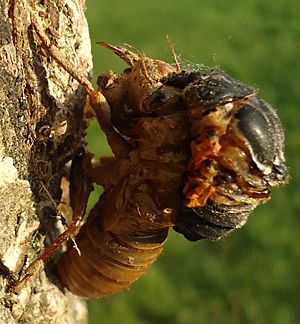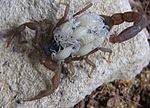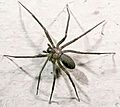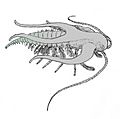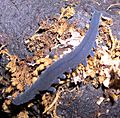Arthropod facts for kids
Quick facts for kids Arthropoda |
|
|---|---|
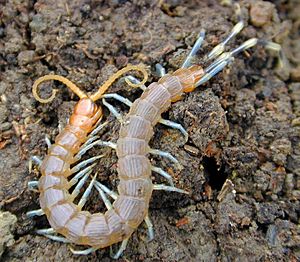 |
|
| Centipede | |
| Scientific classification | |
| Kingdom: | |
| Phylum: |
Arthropoda
|
| Classes | |
|
|
Arthropods are a huge group of animals without backbones. They are called "joint-legged" because their name comes from Greek words meaning just that! This group includes many creatures you know, like insects, spiders, crabs, shrimp, millipedes, and centipedes.
All arthropods share three main features:
- They have jointed legs.
- Their bodies are divided into sections, like a train.
- They wear a hard outer shell called an exoskeleton.
Arthropods have more species than any other animal group. There are about 900,000 known species! Just one group of insects, the beetles, has more species than all other animals combined. Scientists say insects are the most diverse living things ever.
Most arthropods live on land. They are the only group of invertebrates that mostly live on land. Their hard exoskeleton helps them by stopping them from drying out. Arthropods were also the first animals to develop true flight.
There are four main groups of living arthropods: insects, arachnids (like spiders), crustaceans (like crabs), and myriapods (like millipedes). There's also an extinct group called trilobites. Trilobites are famous fossils, second only to dinosaurs! Arthropods are an important food source for many animals, including people.
Contents
What Makes an Arthropod Special?
Arthropods are invertebrates, meaning they do not have a spine. Their bodies are divided into segments, and they have jointed limbs. These limbs are part of their exoskeleton, which is mostly made of a tough material called chitin. Chitin is a bit like the material in your fingernails.
Arthropods also have bodies that are symmetrical, meaning if you cut them down the middle, both sides would be mirror images. They have a brain at the top of their head and a nerve cord running along their belly. Another group of animals, the tetrapods (like us!), also have jointed limbs. But tetrapods are vertebrates and have inner skeletons, not outer ones.
How Many Kinds of Arthropods Are There?
Scientists believe there are at least 1.17 million known species of arthropods. This means they make up over 80% of all known animal species! Some studies even guess there could be between 5 to 10 million arthropod species, including those not yet discovered. It is very hard to count them all. For example, in 1992, a study found 365,000 arthropod species in Costa Rica alone.
Arthropods live in many places: in the ocean, in fresh water, on land, and in the air. They are one of only two major animal groups that have adapted to living in dry places. The other group is amniotes, which includes reptiles, birds, and mammals. Insects are the most diverse group of animals in land and freshwater environments.
Some insects are super tiny, weighing less than 25 millionths of a gram. Others are much heavier, weighing over 70 grams. Some living crustaceans are huge, like the Japanese spider crab, whose legs can spread up to 4 meters (about 13 feet) wide!
The Amazing Exoskeleton
The arthropod exoskeleton is like a suit of armor. It is made of a material called cuticle, which is produced by their skin. The cuticle has three main layers:
- The epicuticle: A thin, waxy outer layer that keeps moisture in and protects the other layers.
- The exocuticle: This layer is made of chitin and hardened proteins, making it strong.
- The endocuticle: This inner layer also has chitin but is not as hard.
Together, the exocuticle and endocuticle are called the procuticle. Each body segment and limb part of an arthropod is covered by this hard cuticle. But the joints between segments and limbs have flexible cuticle, allowing them to move.
Many water-dwelling crustaceans make their exoskeletons even stronger by adding calcium carbonate from the water. This makes their armor tougher. Some land crustaceans can store this mineral because they cannot get it easily from their surroundings. This strong, mineral-filled exoskeleton is cheaper for them to build than an all-organic one.
The exoskeleton can also have bristles called setae. These setae are like tiny hairs and have many uses. They can act as sensors to feel air or water currents, or to touch objects. Some aquatic arthropods use feathery setae to help them swim or to filter food from water. Aquatic insects use thick, felt-like setae to trap air, helping them stay underwater longer. Heavy, stiff setae can even act as defensive spines.
Arthropods use muscles attached to the inside of their exoskeleton to bend their limbs. Some, like spiders, also use water pressure to extend their legs. Spiders can create pressure up to eight times their normal resting level to move their legs!
Why Arthropods Molt (Shed Their Skin)
Since the exoskeleton cannot stretch, arthropods must shed it to grow. This process is called molting. They grow a new, soft exoskeleton underneath the old one, then shed the old, hard shell. Molting happens regularly until the arthropod reaches its full size.
Here is how molting works:
- The animal stops eating.
- Its skin releases a special fluid with enzymes. These enzymes digest the inner layer of the old exoskeleton, making it detach.
- The skin then grows a new outer layer to protect itself from the enzymes.
- While the old shell is detaching, the new outer layer of the exoskeleton starts to form.
- Once the old shell is loose, the arthropod takes in a lot of water or air to swell its body. This makes the old shell split along weak spots.
- The animal struggles out of its old shell, which can take several minutes.
- The new exoskeleton is soft and wrinkled, making the animal weak and hard to move.
- The arthropod keeps pumping itself up to stretch the new shell as much as possible.
- Then, the new outer layer hardens, and the animal gets rid of the extra air or water.
- Finally, the new inner layer of the exoskeleton forms. Many arthropods even eat their old shell to get back the materials!
Molting is a very dangerous time for arthropods. They are unprotected and cannot move well, making them easy targets for predators. Molting might be the cause of 80% to 90% of all arthropod deaths.
How Arthropods Sense the World
Arthropods have amazing ways to sense their surroundings, even with their stiff exoskeletons. Their exoskeletons have many sensors or connections to their nervous system. They have developed special sensors:
- Touch sensors: Mostly setae (bristles) that feel different levels of force, from strong contact to light air currents.
- Chemical sensors: These are like our senses of taste and smell, often found on setae.
- Pressure sensors: These can be like tiny eardrums, connected directly to nerves.
- Antennae: Many insects have antennae with sensors that check humidity, moisture, and temperature.
Most arthropods have advanced vision. They usually have both compound eyes and simple eyes called ocelli.
- Ocelli: These "little eyes" usually only tell the direction light is coming from. However, the main eyes of spiders are ocelli that can form images. Jumping spiders can even rotate their eyes to track prey!
- Compound eyes: These eyes are made of many tiny, independent units called ommatidia. Each ommatidium is a separate sensor with its own light-sensitive cells, and often its own lens and cornea. Compound eyes give a wide view and can detect fast movement and even the polarization of light. However, the images they see are not as clear as what birds or mammals see. Objects within 20 centimeters (about 8 inches) are most important to most arthropods. Many arthropods can see colors, and some insects, like bees, can even see ultraviolet light!
Most arthropods do not have balance sensors and rely on their eyes to know which way is up. For example, cockroaches know to flip over if their feet do not feel pressure. However, many crustaceans have special balance organs called statocysts, which work like the balance sensors in our inner ear.
Arthropods also have proprioceptors. These sensors tell them how much force their muscles are using and how much their body and joints are bending.
Reproduction and Life Cycle
Some arthropods, like barnacles, are hermaphrodites. This means each individual has both male and female reproductive organs. However, most arthropods are either male or female for their whole lives. A few species of insects and crustaceans can reproduce without a mate, a process called parthenogenesis. This often happens when conditions are good for a quick population increase. But most arthropods reproduce sexually. Species that can reproduce without a mate often switch back to sexual reproduction when conditions are less favorable.
Water-dwelling arthropods might release their eggs and sperm into the water, like frogs do. Land arthropods always use internal fertilization, where the sperm fertilizes the egg inside the female's body.
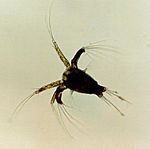
Most arthropods lay eggs. However, scorpions are viviparous, meaning they give birth to live young after the eggs hatch inside the mother. Scorpions are also known for taking care of their babies for a long time.
Newly hatched arthropods look very different from each other. Insects show the widest range of appearances:
- Some hatch looking like tiny adults, like silverfish. These babies might not even eat until after their first molt.
- Many insects hatch as grubs or caterpillars. These young forms do not have segmented limbs or hard exoskeletons. They go through a process called metamorphosis, where they change into adult forms. During this change, they enter an inactive stage where their larval body breaks down and rebuilds into the adult body.
- Dragonfly larvae have the typical hard exoskeleton and jointed limbs of arthropods. But they cannot fly and breathe underwater with special jaws.
- Crustaceans often hatch as tiny larvae called nauplius larvae. These larvae only have three body segments and a few pairs of appendages.
Arthropods
Images for kids
-
Structure of a biramous appendage.
-
Marrella, an ancient arthropod from the Burgess Shale.
-
The velvet worm (Onychophora) is closely related to arthropods.
-
Insects and scorpions on sale in a food stall in Bangkok, Thailand.
See also
 In Spanish: Arthropoda para niños
In Spanish: Arthropoda para niños


